Related Research Articles

Hunting is the human practice of seeking, pursuing, capturing, or killing wildlife or feral animals. The most common reasons for humans to hunt are to exploit the animal's body for food and useful animal products, for recreation/taxidermy, although it may also be done for non-exploitative reasons such as removing predators dangerous to humans or domestic animals, to eliminate pests and nuisance animals that damage crops/livestock/poultry or spread diseases, for trade/tourism, or for ecological conservation against overpopulation and invasive species.

Tehama County is a county located in the northern part of the U.S. state of California. As of the 2020 census, the population was 65,829. The county seat and largest city is Red Bluff.

Red Bluff is a city in and the county seat of Tehama County, California, United States. The population was 14,710 at the 2020 census, up from 14,076 at the 2010 census.

Chronic wasting disease (CWD), sometimes called zombie deer disease, is a transmissible spongiform encephalopathy (TSE) affecting deer. TSEs are a family of diseases thought to be caused by misfolded proteins called prions and include similar diseases such as BSE in cattle, Creutzfeldt-Jakob disease (CJD) in humans and scrapie in sheep. In the United States, CWD affects mule deer, white-tailed deer, red deer, sika deer, elk, caribou, and moose. Natural infection causing CWD affects members of the deer family. Experimental transmission of CWD to other species such as squirrel monkeys and genetically modified mice has been shown.

Lassen Volcanic National Park is an American national park in northeastern California. The dominant feature of the park is Lassen Peak, the largest plug dome volcano in the world and the southernmost volcano in the Cascade Range. Lassen Volcanic National Park is one of the few areas in the world where all four types of volcano can be found—plug dome, shield, cinder cone, and stratovolcano.
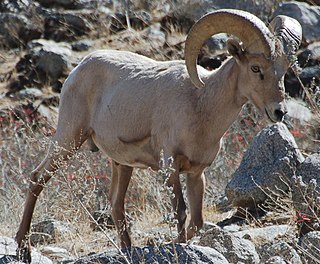
The desert bighorn sheep is a subspecies of bighorn sheep that is native to the deserts of the United States' intermountain west and southwestern regions, as well as northwestern Mexico. The Bureau of Land Management considered the subspecies "sensitive" to extinction.

Wildlife crossings are structures that allow animals to cross human-made barriers safely. Wildlife crossings may include underpass tunnels or wildlife tunnels, viaducts, and overpasses or green bridges ; amphibian tunnels; fish ladders; canopy bridges ; tunnels and culverts ; and green roofs.

The chital or cheetal, also known as the spotted deer, chital deer and axis deer, is a deer species native to the Indian subcontinent. It was first described and given a binomial name by German naturalist Johann Christian Polycarp Erxleben in 1777. A moderate-sized deer, male chital reach 90 cm (35 in) and females 70 cm (28 in) at the shoulder. While males weigh 70–90 kg (150–200 lb), females weigh around 40–60 kg (88–132 lb). It is sexually dimorphic; males are larger than females, and antlers are present only on males. The upper parts are golden to rufous, completely covered in white spots. The abdomen, rump, throat, insides of legs, ears, and tail are all white. The antlers, three-pronged, are nearly 1 m long.
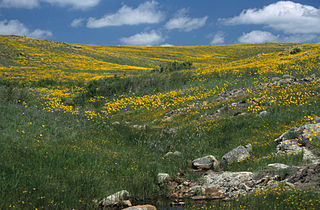
Wichita Mountains Wildlife Refuge, located in southwestern Oklahoma near Lawton, has protected unique wildlife habitats since 1901 and is the oldest managed wildlife facility in the United States Fish and Wildlife Service system. The refuge's location in the geologically unique Wichita Mountains and its areas of undisturbed mixed grass prairie make it an important conservation area. The Wichita Mountains are approximately 500 million years old. Measuring about 59,020 acres (238.8 km2), the refuge hosts a great diversity of species: 806 plant species, 240 species of birds, 36 fish, and 64 reptiles and amphibians are present.
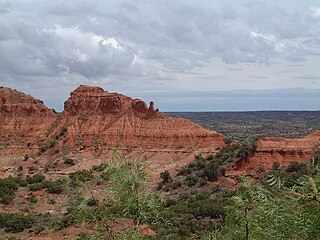
Caprock Canyons State Park and Trailway is a Texas state park located along the eastern edge of the Llano Estacado in Briscoe County, Texas, United States, approximately 100 miles (160 km) southeast of Amarillo. The state park opened in 1982 and is 15,314 acres (6,197 ha) in size, making it the third-largest state park in Texas.
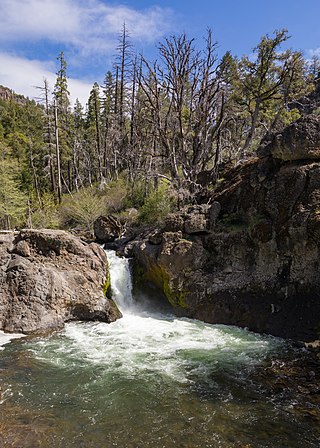
Deer Creek is a 60-mile-long (97 km) southwestward-flowing stream in Northern California that flows through Tehama County, California. It is an eastside tributary of the Sacramento River. As one of only three remaining Sacramento River tributaries supporting native runs of the genetically distinct Central Valley spring-run Chinook salmon, it is a stronghold for this state and federally endangered fish as well as other salmonids.
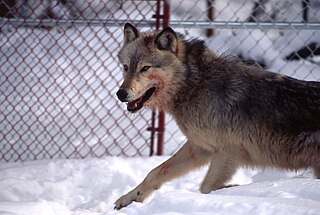
Wolf reintroduction involves the reintroduction of a portion of grey wolves in areas where native wolves have been extirpated. More than 30 subspecies of Canis lupus have been recognized, and grey wolves, as colloquially understood, comprise nondomestic/feral subspecies. Reintroduction is only considered where large tracts of suitable wilderness still exist and where certain prey species are abundant enough to support a predetermined wolf population.
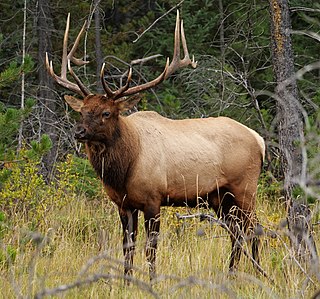
The elk, or wapiti, is one of the largest species within the deer family, Cervidae, and one of the largest terrestrial mammals in its native range of North America and Central and East Asia. The word "elk" originally referred to the European variety of the moose, Alces alces, but was transferred to Cervus canadensis by North American colonists. The name "wapiti", derived from a Shawnee and Cree word meaning "white rump", is also used for C. canadensis.
Dales is an unincorporated community approximately 10 miles (16 km) north east of Red Bluff, on California State Route 36, at the intersection of Manton Road, in Tehama County, California, United States.

The tule elk is a subspecies of elk found only in California, ranging from the grasslands and marshlands of the Central Valley to the grassy hills on the coast. The subspecies name derives from the tule, a species of sedge native to freshwater marshes on which the Tule elk feeds. When the Europeans first arrived, an estimated 500,000 tule elk roamed these regions, but by 1870 they were thought to be extirpated. However, in 1874–1875 a single breeding pair was discovered in the tule marshes of Buena Vista Lake in the southern San Joaquin Valley. Conservation measures were taken to protect the species in the 1970s. Today, the wild population exceeds 4,000. Tule elk can reliably be found in Carrizo Plain National Monument, Point Reyes National Seashore, portions of the Owens Valley from Lone Pine to Bishop, on Coyote Ridge in Santa Clara Valley, San Jose, California and in Pacheco State Park and areas surrounding San Luis Reservoir near Los Banos, California.

The Ishi Wilderness is a 41,339 acre wilderness area located on the Lassen National Forest in the Shasta Cascade foothills of northern California, United States. The Ishi Wilderness is located approximately 20 miles (32 km) east of Red Bluff. The wilderness was created when the US Congress passed the California Wilderness Act of 1984. The land is etched by wind and water, and dotted with basalt outcroppings, caves, and unusual pillar lava formations. The land is a series of east-west running ridges framed by rugged river canyons, with the highest ridges attaining elevations of 4,000 feet (1,200 m). Deer Creek and Mill Creek are the principal drainages and flow into the Sacramento River.

Vina is a census-designated place (CDP) in Tehama County, California. Vina sits at an elevation of 210 feet (64 m). The 2010 United States census reported Vina's population was 237.

Santa Clara County, officially the County of Santa Clara, is the sixth-most populous county in the U.S. state of California, with a population of 1,936,259, as of the 2020 census. Santa Clara County and neighboring San Benito County together form the U.S. Census Bureau's San Jose–Sunnyvale–Santa Clara metropolitan statistical area, which is part of the larger San Jose–San Francisco–Oakland combined statistical area. Santa Clara is the most populous county in the San Francisco Bay Area and in Northern California. The county seat and largest city is San Jose; with about 1,000,000 residents, it is the 10th-most populous city in the United States, California's third-most populous city and the most populous city in the San Francisco Bay Area. The second- and third-largest cities are Sunnyvale and Santa Clara.

American Prairie is a prairie-based nature reserve in Central Montana being developed as a private project of the American Prairie Foundation (APF). This independent non-profit organization is creating a wildlife conservation area that aims to cover over 3 million acres (12,000 km2) through a combination of both private and public lands to restore a mixed grass prairie ecosystem with migration corridors and native wildlife.

In late December 2011, OR-7, a male gray wolf from Oregon, became the first confirmed wild wolf in California since 1924, when wolves were considered extirpated from the state. The first resident wolf pack was confirmed in 2015, after two adults migrated from Oregon and had five pups. Additional wolves have been tracked during their natural expansion into state, as the Cascade Range, which wolves have repopulated in Oregon, extends south into northern California. In 2021, the state had at least two wolf packs with pups for the first time in over a hundred years. It is likely that other uncollared wolves are dispersing through portions of their historic habitat in California.
References
- ↑ "California Buck Outlook". Western Hunter. 2000.
- 1 2 Roberts, Rich (November 13, 1991). "They're Keeping Track: State Monitors Deer With Radio Transmitters in Tehama Wildlife Area, Covering 44,000 Acres". Los Angeles Times . Archived from the original on July 26, 2023. Retrieved July 26, 2023.
- ↑ "Tracks" (PDF). California Department of Fish and Game. 2001. Archived from the original (PDF) on 2010-10-08.